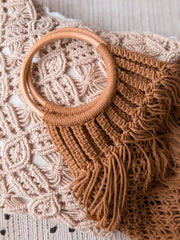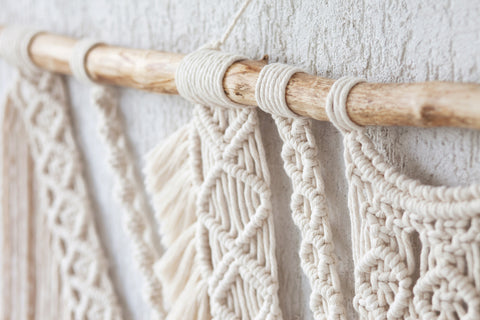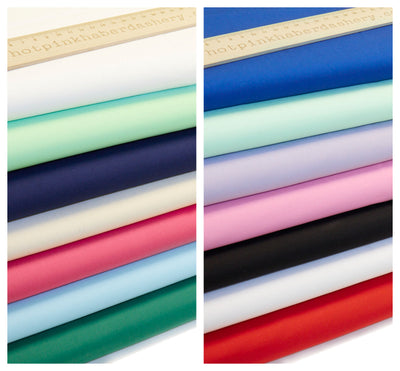A Beginner's Guide To Macramé
What Is Macramé?
Macramé is a craft that uses creative knotting techniques to produce different types of decorative textiles such as bags, jewellery, planters and wall hangings. Macramé textiles are traditionally made from specialist cotton macramé cords but can also be made from ropes of hemp, leather, jute, fabric or yarn. To create each piece, macramé cords are hand tied using specialist knots to form decorative knotting patterns. Macramé uses a set of different styles of knots, for different purposes, helping to shape and structure the final piece.
Macramé has a fascinating history – it is a craft that dates back centuries. Over time its popularity has waxed and waned according to lifestyle trends, however in recent years the appeal of macramé has been reignited again. Thanks to a plethora of online inspiration and step–by–step macramé guides, macramé has become a very aspirational craft for people to follow.
Macramé is a great craft for beginners to learn, with a wealth of online video tutorials available to help you. It is also a very accessible craft, requiring just a few low-cost materials to get started and build your macramé kit. Macramé is a relaxing activity that you can pick up and return to, whenever you have free time. Once you are familiar with a few key knotting styles, there is a whole range of striking projects that can be made in under 30 minutes.
The History of Macramé
So when was macramé invented? The technique of tying decorative knots can be traced back as far as the Babylonians and Assyrians, where fringe plaiting was seen adorning costumes in period carvings.
However, it is widely believed that the practice of using decorative knotting techniques became much more prevalent during the 13th century by Arab weavers. Excess threads along the edges of handwoven fabrics like towels, shawls and veils were knotted into attractive fringes. This popularity of this technique helped to establish the art of macramé. In fact, the word macramé is thought to be derived from either the Arabic word ‘macramia’, meaning ‘ornamental fringe’ or the Turkish word ‘makrama’, meaning napkin or towel.
The Moors introduced the craft to Spain, where the technique then steadily spread across Europe and, later, macramé was brought to the court of Queen Mary II in England during the 17th century. However, it was during the Victorian era that the craft’s popularity soared, becoming featured in household textiles such as tablecloths, bedspreads and curtains. In 1882, a specialist guide called Sylvia’s Book of Macramé Lace further popularised the craft by demonstrating how to make trimmings for “costumes, both for home wear, garden parties, seaside ramblings and balls”.
During the same era, European sailors adopted the process and made macramé objects such as belts and hammocks to be sold at ports around the world. Sailors named the technique ‘square knotting’ after the most popular macramé knot and introduced the craft to China and the New World.
Macramé fell out of favour for a number of years but experienced a resurgence during the 1970s hippie movement, becoming an iconic part of the era’s fashion. Today, the craft is enjoying even greater popularity, thanks to the bohemian decor trend and a wealth of inspiring macramé blogs and online tutorials.

What Can I Make From Macramé?
There are so many beautiful projects that can be made from macramé and, as your experience and knowledge increases, you’ll be inspired to try more elaborate and creative ideas. Macramé is used for all kinds of decorative textiles from the classic plant holder to wall hangings, shopping bags, cushion covers, jewellery, Christmas trimmings and much more! Here's just a few ideas to get you started:
- Home decor – Macramé makes beautiful home accessories, such as a statement wall hanging, pretty coasters, cushion covers, table runners, curtains, dream catchers and even hanging chairs! Macramé makes great seasonal decorations too, with Christmas trimmings and tree decor a popular macramé activity!
- Fashion accessories – Macramé is definitely a look you'll be proud to try on and it's so adaptable too! Try macramé necklaces, earrings, bracelets, shopping bags, key chains, belts and even bag and lanyard straps!
Once you've developed a knowledge of different knots, you can play with the design of your macramé pieces. Macramé accessories, such as macramé beads, rings and dowels are a great way to embellish your project or add structure where needed. Our 39 piece macramé accessories pack is a great product to have in your macramé kit – it includes a great selection of accessories for you to play with and add to your designs.

How To Get Started With Macramé
We recommend starting with a simple project, such as a planter or coaster, so you can get to know the basics and practise the macramé knotting techniques. It's worthwhile doing some online research to find a few free tutorials and step-by-step guides that you can follow to help you. There's a great selection of free macramé patterns that you can access to get started! Additionally, there are macramé Facebook groups available for support, advice and inspiration.
The website macraméforbeginners.com has a great selection of easy project tutorials, including video guides for everything from planters to adorable Christmas decorations. Also, check out Isabella Strambio’s website for free step-by-step photographic tutorials of stunning, modern macramé designs and macramé knotting techniques. Isabella is a macramé artist and author of Macramé For The Modern Home, bringing the craft up-to-date with inspiring decor ideas.
Once you've researched and decided on your first macramé project, you just need to purchase your macramé cord along with a few materials listed below.
What Materials Do I Need For Macramé?
The good news is that you don’t have to invest a great deal of money upfront to get started with macramé and a few essential tools is all you need.
– A pair of good quality sharp scissors, such as Fiskars RazorEdge Softgrip shears.
– A tape measure, which is essential for measuring the cords
– Masking tape or T-pins to hold your piece in place as you work.
– Cord of a suitable material and width for your project
– A macramé board is very useful for securing your macramé pieces.
– Macramé accessories, such as macramé beads, rings and dowels if you're planning to incorporate these into your project.
What Macramé Cord Should I Buy?
Cotton macramé cord is widely regarded as the best type of macramé cord, as it is soft, flexible and easy to work with. Cotton macramé cord is available in different widths, to suit your chosen project. Here's a quick guide to help you choose the right macramé cord for your project:
1.5 – 3mm macramé cord: Ideal for small scale & more delicate designs such as jewellery, coasters, Christmas tree decorations and purses.
3 – 5mm macramé cord: Suitable for medium size projects such as planters, small wall hangings and shopping bags.
4 – 7mm macramé cord: Ideal for large scale pieces like bigger wall hangings and backdrops.
A good tutorial should also recommend the ideal width of macramé cord to use for your project. You may also find that projects will recommend different types of cord, according to how the cord is woven. There are 3 main types of macramé cords:
- Single twist cords mean that the cotton fibres are twisted together into a single rope. This cord brushes out easily if you plan to finish your project with a neat fringe.
- 3 ply or triple twist cords combine three single twist ropes into one cord. It has a firmer hold and can be brushed out into a curly fringe.
- Braided cords are stretchy and are flexible by nature, so not as commonly used and aren’t suitable for fringe details.

What Knots Are Used in Macramé?
There are some key types of macramé knot that are essential to getting started on your macramé projects. With a little practice and some guidance from online tutorials, these knots are straight-forward to master so you’ll be ready to embark on your first macramé piece in no time!
Square Knot:
The square knot is absolutely key to working with macramé – it is a versatile knot with different variations, such as the half square and spiral knots, and is featured across all kinds of projects. The alternative square knot can be used together with a square knot when creating rows, to form an alternating pattern across your textile.
Lark’s Head Knot:
The lark’s head knot and reverse lark’s head are used to attach your cord to a dowel or ring. These knots can also be used to add new cords into your piece.
Hitch Knot:
The decorative hitch knots create beautiful design work in your piece, but do take a little practice to perfect. The knots aren’t essential to starting your macramé journey, however as you gain experience and skill, these knots will bring some lovely details to more complex work. There are different types of hitch knots you can try, such as the half hitch, the double half hitch and variations that can create horizontal, vertical and diagonal patterns.
Gathering Knot:
This group of knots include techniques such as the overhand and wrapping knot styles, used to finish projects at the end of the piece.
For further detailed guidance on specific knot types, you can check out this video, as well as step-by-step photographic guides from sarahmaker.com and Isabella Strambio.
We hope our guide to getting started with macramé has inspired you to begin your own macramé projects. Our macramé range includes all the essential supplies you need to begin your projects. We also stock bag making essentials, as well as accessories for belts, key rings and much more to complement your macramé projects!
We'd love to hear from you!
We always love to see our customers’ finished projects, so please share your photos with us on our Instagram and Facebook pages! If you have a question or would like to share your own tips and advice about working with macramé, please leave us a comment below!







Leave a comment